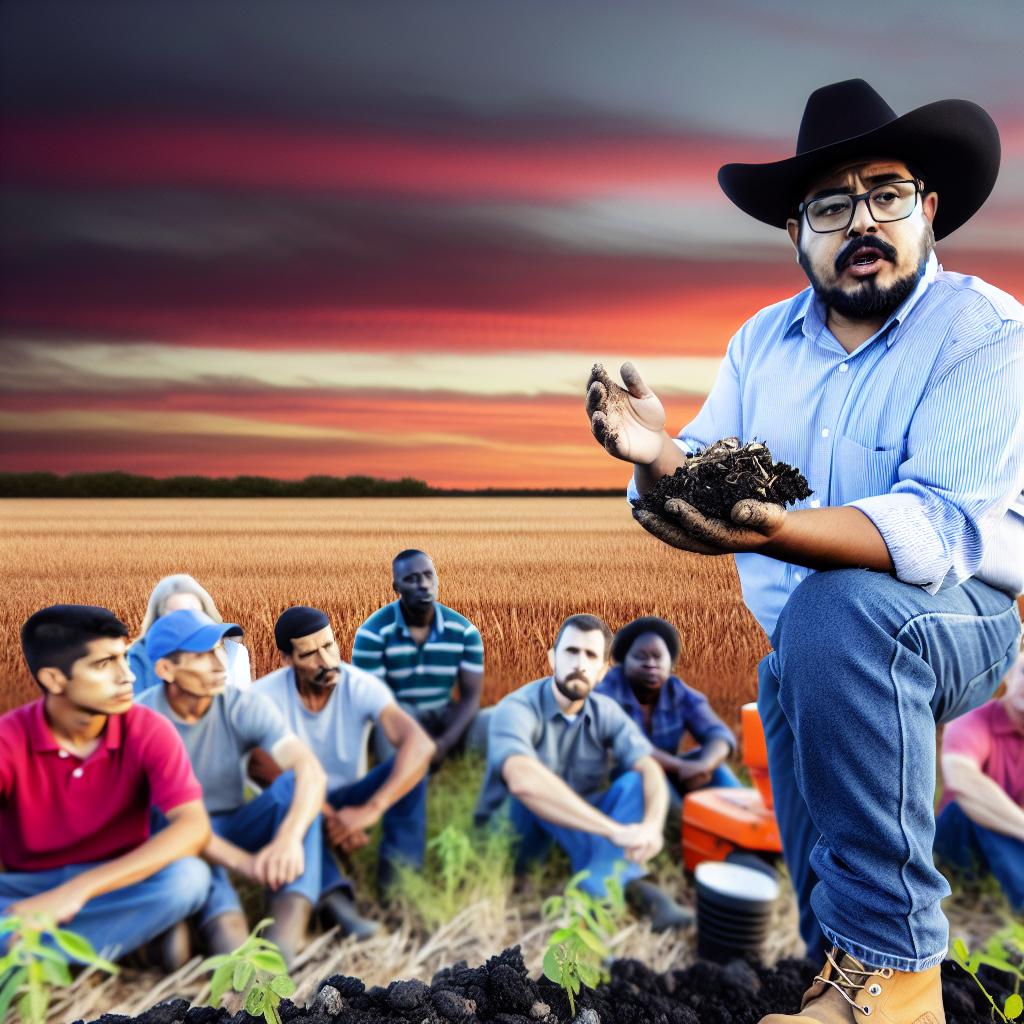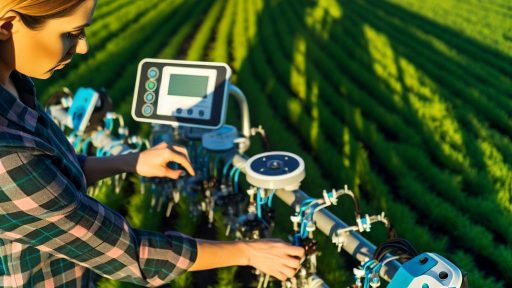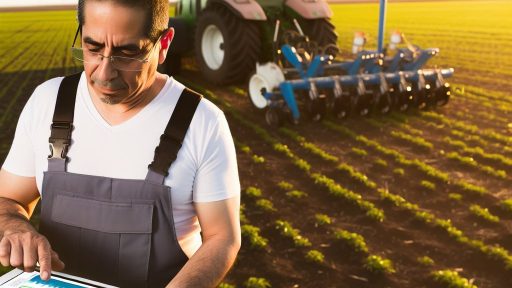Introduction to Conservation Tillage
Definition of Conservation Tillage
Conservation tillage refers to soil management practices that enhance soil health.
It minimizes soil disturbance during planting and cultivation activities.
This method retains crop residue from previous harvests on the soil surface.
Importance of Conservation Tillage
Conservation tillage plays a vital role in sustainable agriculture.
It helps in reducing soil erosion and promoting soil fertility.
Also, it improves water retention in the soil, enhancing drought resilience.
Environmental Benefits
This practice lowers greenhouse gas emissions by reducing machinery use.
Moreover, it supports biodiversity by providing habitat for beneficial organisms.
Conservation tillage also decreases the need for chemical fertilizers.
Economic Advantages
Farmers using conservation tillage often experience reduced operational costs.
It increases overall crop yields due to improved soil conditions.
Furthermore, farmers gain access to government incentives for sustainable practices.
Challenges and Considerations
While conservation tillage offers many benefits, it poses some challenges as well.
Farmers may initially struggle with adapting to new equipment and techniques.
Additionally, there may be difficulties in managing crop residues effectively.
Transform Your Agribusiness
Unlock your farm's potential with expert advice tailored to your needs. Get actionable steps that drive real results.
Get StartedHistorical Overview of Conservation Tillage Practices in Agriculture
Roots of Conservation Tillage
Conservation tillage originated in the mid-20th century.
This practice emerged as a response to soil erosion concerns.
Farmers observed that traditional methods depleted soil quality.
Moreover, these methods contributed to severe erosion problems.
Consequently, agricultural researchers sought more sustainable solutions.
Developing Techniques
During the 1960s, farmers began adopting reduced tillage strategies.
They realized these methods preserved soil structure effectively.
Additionally, reduced tillage helped retain moisture in dry seasons.
Further research during this period refined conservation practices.
Influential Studies and Adoption
Various studies in the 1980s highlighted the benefits of conservation tillage.
These benefits included improved soil health and increased crop yields.
Farmers gradually recognized the long-term advantages of these methods.
By the 1990s, conservation tillage gained significant popularity.
Organizations promoted education and training in sustainable practices.
Modern Adoption Trends
Today, nearly 40% of U.S. farmers use conservation tillage.
This reflects a growing awareness of environmental impacts.
Recent initiatives focus on promoting sustainable agricultural practices.
As a result, conservation tillage continues to evolve and improve.
Challenges and Future Directions
Despite its advantages, some farmers hesitate to adopt conservation tillage.
Challenges include initial costs and lack of knowledge.
Education, research, and targeted support can address these issues.
Future developments will likely focus on enhancing efficiency.
Conservation tillage plays a crucial role in sustainable agriculture.
Types of Conservation Tillage
No-Till Farming
No-till farming preserves soil structure.
Showcase Your Farming Business
Publish your professional farming services profile on our blog for a one-time fee of $200 and reach a dedicated audience of farmers and agribusiness owners.
Publish Your ProfileIt involves planting crops without disturbing the soil.
This technique protects against erosion and nutrient loss.
Farmers use specialized equipment to create narrow seedbeds.
Consequently, soil moisture retention increases significantly.
Research shows it boosts organic matter in the soil.
Reduced-Till Farming
Reduced-till farming incorporates limited soil disturbance.
This approach helps maintain soil health and ecosystem balance.
Farmers typically plow less frequently than in conventional methods.
Thus, it minimizes erosion while improving water infiltration.
Additionally, it encourages beneficial microbial activity.
Farmers often combine this method with cover crops.
Mulch Tillage
Mulch tillage involves applying crop residues to the soil surface.
This practice helps suppress weeds and retain moisture.
Farmers till only the areas where crops will grow.
Thus, it reduces soil compaction and enhances root growth.
Moreover, it supports improved soil fertility.
This method promotes a healthier farming ecosystem overall.
Uncover the Details: Greenhouse Cultivation for Organic Crop Production in the USA
Soil Health Benefits
Enhancing Soil Structure
Conservation tillage enhances soil structure effectively.
This method reduces soil compaction and increases porosity.
Improved porosity allows better air and water movement through the soil.
Moreover, it promotes root penetration and growth.
Healthy soil structure helps in maintaining moisture levels.
Consequently, plants can access water more efficiently during dry periods.
Boosting Soil Fertility
Conservation tillage significantly boosts soil fertility.
This practice increases organic matter in the soil.
Enhancing organic matter enriches soil with vital nutrients for crops.
Additionally, it increases microbial activity, which supports plant health.
Higher microbial activity leads to better nutrient cycling.
As a result, crops receive nutrients when they need them the most.
Reducing Erosion
One of the critical benefits is reducing soil erosion.
Conservation tillage minimizes soil disturbance and preserves topsoil.
The topsoil is essential for plant growth and sustains soil health.
Further, it enhances the land’s resilience against heavy rainfall.
Less erosion means more sustainable land management practices.
This approach can significantly help maintain agricultural productivity over time.
Long-term Sustainability
Adopting conservation tillage leads to long-term sustainability in farming.
This method supports healthier ecosystems and biodiversity in the soil.
Healthy soils retain nutrients and water more effectively.
Ultimately, this enhances crop yields without excessive chemical inputs.
Showcase Your Farming Business
Publish your professional farming services profile on our blog for a one-time fee of $200 and reach a dedicated audience of farmers and agribusiness owners.
Publish Your ProfileFarmers can enjoy improved profitability while practicing environmental stewardship.
See Related Content: The Business Case For Integrating Data-Driven Farming Into Property Ventures
Water Conservation
Reducing Runoff
Conservation tillage plays a vital role in reducing runoff.
This method leaves the soil intact and covered with residue.
As a result, water has more opportunity to infiltrate the ground.
Consequently, the risk of erosion decreases significantly.
Farmers notice enhanced water retention in their fields.
Effective water management ensures a more sustainable farming practice.
Minimizing Erosion
Erosion remains a significant concern for many agricultural operations.
Conservation tillage helps maintain soil structure and health.
This technique reduces soil disturbance during planting.
As a benefit, the likelihood of erosion during heavy rains decreases.
Moreover, the existing crop residue acts as a protective barrier.
Farmers can achieve higher yields by preventing nutrient loss.
Enhancing Soil Health
Healthy soil supports overall plant growth.
Conservation tillage encourages the presence of organic matter.
This organic matter improves soil structure and nutrient cycling.
Furthermore, it fosters a thriving ecosystem of microorganisms.
These factors collectively contribute to better water absorption.
Nutrient-rich soil ultimately supports crop resilience against drought.
Long-Term Benefits
The benefits of conservation tillage extend beyond immediate results.
Farmers witness gradual improvements in soil quality over time.
Additionally, water conservation contributes to sustainable practices.
Less runoff means cleaner water sources nearby.
Farmers can enhance their reputation by adopting eco-friendly methods.
Ultimately, conservation tillage leads to healthier ecosystems.
Explore Further: The Role of Weed Control in Sustainable Land Development
Economic Impacts: Cost-Benefit Analysis of Adoption of Conservation Tillage
Introduction to Cost-Benefit Analysis
Cost-benefit analysis provides insights into the economic impacts of farming practices.
Specifically, it assesses the costs and benefits associated with implementing conservation tillage.
This method helps farmers make informed decisions about their practices.
Initial Investment Considerations
The adoption of conservation tillage often requires an initial investment.
Farmers may need to purchase specialized equipment for effective implementation.
Additionally, there may be costs associated with training and education.
Understanding these upfront costs is crucial for accurate analysis.
Long-Term Financial Benefits
Over time, conservation tillage can reduce operational costs.
For instance, it typically lowers fuel expenditures.
Moreover, it can minimize expenses related to soil amendments.
These long-term savings can significantly outweigh initial investments.
Yield Considerations
Farmers often wonder how conservation tillage affects crop yields.
Research suggests that yields can stabilize or even improve over time.
Showcase Your Farming Business
Publish your professional farming services profile on our blog for a one-time fee of $200 and reach a dedicated audience of farmers and agribusiness owners.
Publish Your ProfileHealthy soils fostered through conservation practices contribute to greater productivity.
Environmental Incentives
Conservation tillage not only benefits farms but also the environment.
Improved soil health leads to enhanced water retention and reduced erosion.
These environmental benefits can translate into financial incentives.
For example, some governments offer subsidies for sustainable practices.
Real-World Examples
Many farmers have successfully adopted conservation tillage.
For instance, Laura Green of Maple Hill Farms noted significant cost reductions.
She reported that transitioning to conservation tillage saved her farm nearly 20% in input costs.
Furthermore, David Reed from Clear Water Agriculture experienced improved yields.
His decision has led to a 15% increase in his corn production over five years.
Challenges in Adoption
Despite the benefits, farmers may face hurdles when adopting conservation tillage.
Soil conditions vary, impacting the effectiveness of certain practices.
Moreover, there may be resistance to changing traditional farming methods.
These challenges necessitate thorough evaluation before implementation.
Future Outlook
The future of conservation tillage appears promising.
As more farmers recognize its benefits, adoption rates are likely to increase.
Continuous research and education will drive successful implementation.
Ultimately, conservation tillage can lead to both financial and environmental sustainability.
Learn More: Fertilizer Management for Sustainable Wheat Farming in the USA

Crop Yield Comparisons
Defining Conventional and Conservation Tillage
Conventional tillage involves the complete soil turnover before planting.
This method often leads to soil compaction and erosion.
In contrast, conservation tillage minimizes soil disturbance.
This technique retains crop residue on the surface, protecting the soil.
Key Factors Influencing Crop Yields
Several factors influence crop yields under different tillage practices.
These include soil health, moisture retention, and pest management.
Additionally, nutrient availability plays a significant role.
Research Findings on Yield Comparisons
Studies have shown varying results for crop yields between tillage methods.
For example, corn yields in conservation tillage can match or exceed conventional yields.
In a study by Dr. Emily Harris, conservation tillage showed a 15% yield increase for soybeans.
Furthermore, wheat production also exhibited positive trends under conservation practices.
Advantages of Conservation Tillage
Conservation tillage helps improve soil structure and health.
This leads to better moisture retention during dry spells.
Moreover, it enhances biodiversity by providing habitats for beneficial organisms.
In addition, conservation tillage reduces the need for chemical herbicides.
Challenges and Considerations
Transitioning to conservation tillage can present challenges for farmers.
For instance, there may be initial yield losses during the switch.
Farmers like Tom Jenkins emphasize the need for patience with this method.
Long-term planning and monitoring are essential for success.
Real-World Applications and Case Studies
Numerous farms have effectively adopted conservation tillage.
The Martin Family Farm reported improved yields and soil health.
Showcase Your Farming Business
Publish your professional farming services profile on our blog for a one-time fee of $200 and reach a dedicated audience of farmers and agribusiness owners.
Publish Your ProfileSimilarly, the Green Pastures Cooperative shared positive feedback on coffee crops.
These success stories inspire other growers to explore conservation options.
Challenges and Limitations
Addressing Misconceptions
Conservation tillage often faces misconceptions about its effectiveness.
Many farmers believe it leads to reduced yields.
However, research shows it can enhance soil health over time.
Moreover, some think it complicates weed management.
In fact, it can improve weed control with proper practices.
Education is crucial in addressing these false beliefs.
Resistance to Change
Many farmers hesitate to adopt conservation tillage techniques.
This resistance often stems from established habits.
Change requires an investment of time and resources.
Some farmers feel uncertain about the benefits of new methods.
Additionally, emotional attachment to traditional practices plays a role.
Overcoming this resistance involves demonstrating clear advantages.
Financial Considerations
Financial concerns can also limit the adoption of conservation tillage.
Initial costs for new equipment may deter farmers.
However, long-term savings on inputs can outweigh these expenses.
Government incentives and grants can help alleviate financial barriers.
Education on cost-benefit analyses is essential.
Environmental Factors
Different climates present unique challenges for conservation tillage.
Soil type and local weather conditions affect its implementation.
Farmers need to understand their specific environmental contexts.
Tailored approaches can enhance the success of conservation tillage.
Side discussions with agronomists can personalize strategies.
Building Support Networks
Creating community support can ease the transition to conservation tillage.
Farmers often benefit from learning from each other’s experiences.
Local agricultural extension services can provide valuable resources.
Workshops and field demonstrations highlight successful practices.
Networking fosters collaboration and knowledge-sharing among peers.
Future Trends in Conservation Tillage Research: Innovations and Technologies
Emerging Technologies
New technologies are reshaping conservation tillage practices daily.
Farmers can leverage precision agriculture tools for improved efficiency.
Drone technology aids in monitoring soil health and crop growth.
Furthermore, advanced sensors enhance data collection processes.
These technologies drive actionable insights for better decision-making.
Continued Research and Development
Ongoing research focuses on soil microbiomes and their impact on crop yield.
Scientists are exploring the benefits of cover crops in diverse ecosystems.
This research aims to increase resilience against climate change.
Moreover, innovations in biopesticides will reduce chemical inputs.
Researchers are collaborating with farmers to share insights and findings.
Integration with Other Agricultural Methods
Conservation tillage is increasingly combined with organic farming strategies.
Showcase Your Farming Business
Publish your professional farming services profile on our blog for a one-time fee of $200 and reach a dedicated audience of farmers and agribusiness owners.
Publish Your ProfileThis integration promotes soil health while ensuring economic viability.
Agroforestry practices enhance land use efficiency and biodiversity.
Additionally, crop rotation methods can optimize conservation efforts.
Farmers are seeing tangible benefits from these integrated approaches.
Government Policies and Support
Governments worldwide are recognizing the importance of sustainable practices.
Policies are evolving to support conservation tillage adoption.
Incentives for farmers to adopt innovative technologies are expanding.
Research grants are becoming more accessible for sustainability projects.
This support encourages a shift towards more environmentally friendly farming.
Case Studies: Successful Implementation of Conservation Tillage in Different Regions
Midwest United States
In the Midwest, farmers adopted conservation tillage to reduce soil erosion.
Jane Thompson, a corn farmer in Iowa, reported improved yields since switching techniques.
This method retained moisture and enhanced soil structure over time.
Moreover, local extension services provided valuable training in best practices.
Southern Brazil
In Southern Brazil, conservation tillage has transformed agricultural practices.
Carlos Silva, a soybean farmer, embraced these methods to combat deforestation.
He noted that the strategy improved biodiversity and soil health significantly.
Additionally, farmers collaborated with universities for ongoing research and adaptation.
Western Australia
Western Australia has seen positive outcomes from conservation tillage as well.
Emily Carter, a wheat grower in the region, highlighted increased resilience to drought.
She implemented cover crops as part of her tillage approach.
This not only protected the soil but also facilitated nutrient cycling.
Eastern Europe
In Eastern Europe, adoption rates of conservation tillage are rising.
Petro Ivanov, a young farmer in Ukraine, is an early adopter of these techniques.
His early investments in machinery paid off through lower fuel costs.
Peer networks are forming to share experiences and promote learning.
Key Takeaways from Case Studies
- Conservation tillage enhances soil health and productivity.
- Local experts play a vital role in education and implementation.
- Adaptation to climate challenges becomes easier with effective strategies.
- Collaboration among farmers and researchers drives innovation.




